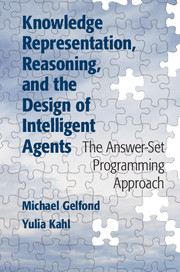 Knowledge Representation, Reasoning, and the Design of Intelligent Agents
Knowledge Representation, Reasoning, and the Design of Intelligent Agents Book contents
- Frontmatter
- Dedication
- Contents
- Preface
- 1 Logic-Based Approach to Agent Design
- 2 Answer Set Prolog (ASP)
- 3 Roots of Answer Set Prolog
- 4 Creating a Knowledge Base
- 5 Representing Defaults
- 6 The Answer-Set Programming Paradigm
- 7 Algorithms for Computing Answer Sets
- 8 Modeling Dynamic Domains
- 9 Planning Agents
- 10 Diagnostic Agents
- 11 Probabilistic Reasoning
- 12 The Prolog Programming Language
- Appendix A ASP Solver Quick-Start
- Appendix B Aspide
- Appendix C Introduction to SPARC
- Appendix D Code
- Bibliography
- Index
4 - Creating a Knowledge Base
Published online by Cambridge University Press: 05 July 2014
- Frontmatter
- Dedication
- Contents
- Preface
- 1 Logic-Based Approach to Agent Design
- 2 Answer Set Prolog (ASP)
- 3 Roots of Answer Set Prolog
- 4 Creating a Knowledge Base
- 5 Representing Defaults
- 6 The Answer-Set Programming Paradigm
- 7 Algorithms for Computing Answer Sets
- 8 Modeling Dynamic Domains
- 9 Planning Agents
- 10 Diagnostic Agents
- 11 Probabilistic Reasoning
- 12 The Prolog Programming Language
- Appendix A ASP Solver Quick-Start
- Appendix B Aspide
- Appendix C Introduction to SPARC
- Appendix D Code
- Bibliography
- Index
Summary
To reason about the world, an agent must have information about it. Because it is unreasonable to teach an agent everything there is to know, we decide on what kind of agent we are building and educate it accordingly. The collection of statements about the world we choose to give the agent is called a knowledge base. In this chapter we create several knowledge bases using the declarative approach. The emphasis is on the methodology of knowledge representation and the use of ASP. Using examples in several, very different domains, we emphasize the importance of the following:
modeling the domain with relations that ensure a high degree of elaboration tolerance;
the difference between knowledge representation of closed vs open domains; i.e., we need to know when we can assume that our information about a relation is complete and when we should instead reason with incomplete information, but realize that we are doing so (reasoning with incomplete information is covered much more thoroughly in Chapter 5);
representing commonsense knowledge along with expert knowledge;
recursive definitions and hierarchical organization of knowledge.
The first knowledge base contains various relationships within the family group, the second models electrical circuits, and the third deals with a basic taxonomic hierarchy that includes classes such as “submarine” and “vehicle.” (For now we only make use of basic rules and recursion. More sophisticated knowledge bases are discussed in later chapters.)
- Type
- Chapter
- Information
- Knowledge Representation, Reasoning, and the Design of Intelligent AgentsThe Answer-Set Programming Approach, pp. 61 - 85Publisher: Cambridge University PressPrint publication year: 2014


